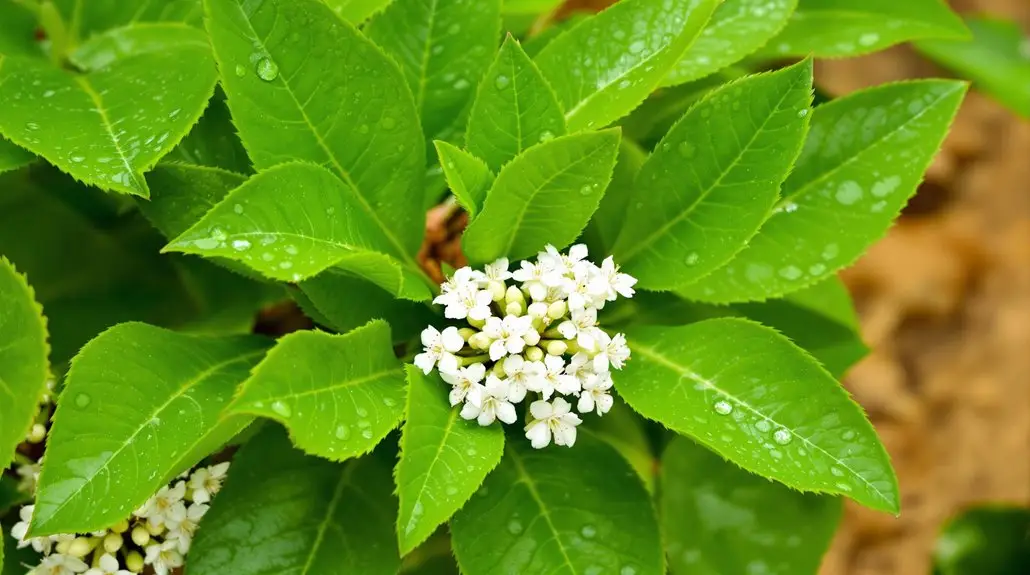Myrtle, or *Myrtus communis L.*, packs a powerful punch with its diverse pesticidal composition. You'll find key components like α-pinene, linalool, and 1,8-cineole, all known for their effectiveness against pests and pathogens. These compounds exhibit insecticidal and antifungal properties, making them ideal for sustainable agriculture. Myrtle essential oil has shown high efficacy against various pests, including Tetranychus urticae and Aedes aegypti, along with strong antibacterial and antimicrobial effects. Variations in chemical makeup based on region and season can influence these activities. There's much more to uncover about its applications and benefits—keep exploring for deeper insights!
Key Insights
- Myrtle essential oil contains key components like 1,8-cineole, linalool, and α-pinene, contributing to its pesticidal properties.
- The oil exhibits significant insecticidal activity against various pests, including *Aedes aegypti* and *Culex pipiens*.
- Antifungal properties are notable, effectively combating pathogens such as *Candida* and *Aspergillus* species.
- Myrtle extracts show antibacterial activity against harmful strains like *Escherichia coli* and MRSA, enhancing pest control strategies.
- Seasonal and regional variations impact the chemical composition and effectiveness of Myrtle essential oils in pest management applications.
Essential Oil Composition
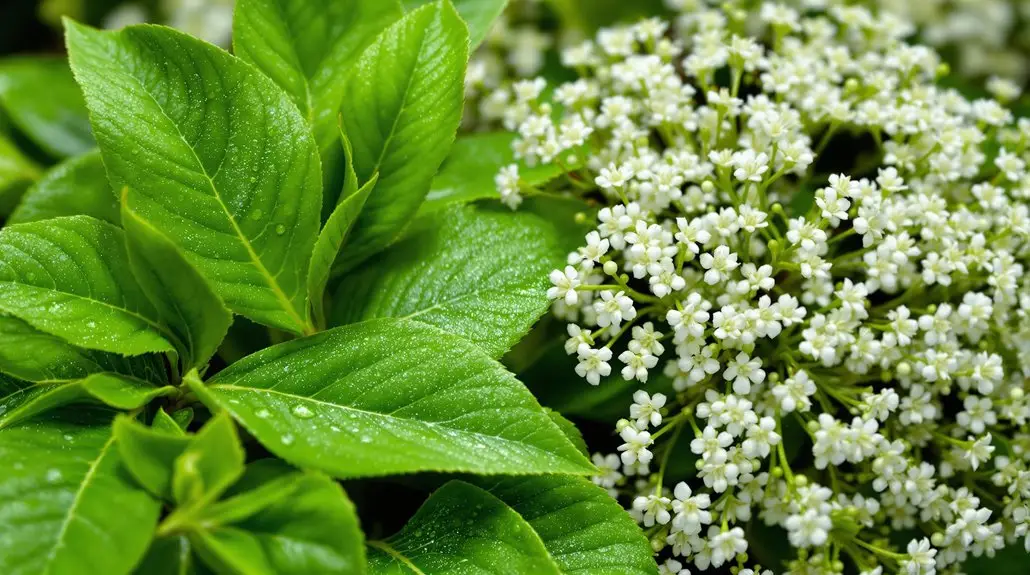
When it comes to essential oils from Myrtle, you'll find two main types: Green Myrtle and Red Myrtle, both sourced from *Myrtus communis L.* The key differences lie in their chemical compositions; Green Myrtle has higher levels of a-pinene, while Red Myrtle boasts more 1,8-cineole. This distinction isn't just academic—it influences how you might use these oils in your daily life.
Green Myrtle, typically sourced from Corsica, is known for its higher myrtenyl acetate and linalool content, contributing to its fresh, green aroma. When you smell this oil, it's like inviting a breath of nature into your home. Additionally, Green Myrtle's aromatic characteristics make it particularly appealing for use in aromatherapy applications. Moreover, both types of Myrtle essential oils possess antiseptic properties that can aid in respiratory health, similar to the organic pest control services offered by NaturePest.
On the other hand, Red Myrtle, sourced from Morocco or Albania, presents a more camphorous scent with its rich, orange-red hue. This oil's unique properties make it an excellent candidate for those moments when you need a little extra support, whether in wellness or fragrance.
Both types are extracted primarily through steam distillation, a process that captures the essence of Myrtle while preserving its aromatic integrity. The leaves undergo careful dehydration with anhydrous sodium, ensuring you receive a high-quality product.
As you explore these oils, you'll discover how their distinct compositions can enhance your life, from natural remedies to delightful scents. Embracing Myrtle essential oils means connecting with nature and finding a sense of belonging in the world of holistic wellness.
Major Chemical Components
Analyzing the major chemical components of Myrtle essential oil reveals a rich tapestry of compounds that contribute to its diverse applications. You'll find that certain key constituents, such as α-pinene, 1,8-cineole, and linalool, are consistently present across various studies. These compounds not only offer aromatic qualities but also exhibit notable pesticidal activities.
Here are some significant components you should know about:
- 1,8-cineole (eucalyptol): Known for its fumigant activity, it's effective against specific insects.
- Linalool: Frequently identified in Myrtle oil, this compound shares similar insecticidal properties.
- α-pinene: This common monoterpene is recognized for its insecticidal effects and adds to the oil's aromatic profile.
In addition to these primary components, Myrtle oil showcases variability with compounds like myrtenyl acetate and geranyl butyrate appearing in certain extracts. This diversity indicates potential for tailored applications in pest control based on regional variations. Furthermore, the presence of compounds like caryophyllene oxide and α-terpineol suggests enhanced efficacy in combating pests. The effectiveness of these compounds aligns with the growing trend toward natural and organic pest control solutions.
Essential oils derived from Myrtus communis exhibit significant antibacterial properties, highlighting their potential role in *integrated pest management* strategies. Notably, the essential oil of Myrtle has been recognized for its therapeutic potential in various applications. As you explore Myrtle's essential oil, remember that its phytochemical richness can lead to innovative solutions in agricultural practices. The blend of these compounds reflects the oil's potential not just for pest management but also for broader applications in health and wellness.
Embracing this knowledge, you can appreciate the multifaceted nature of Myrtle and its role in sustainable practices.
Regional Variations in EOs
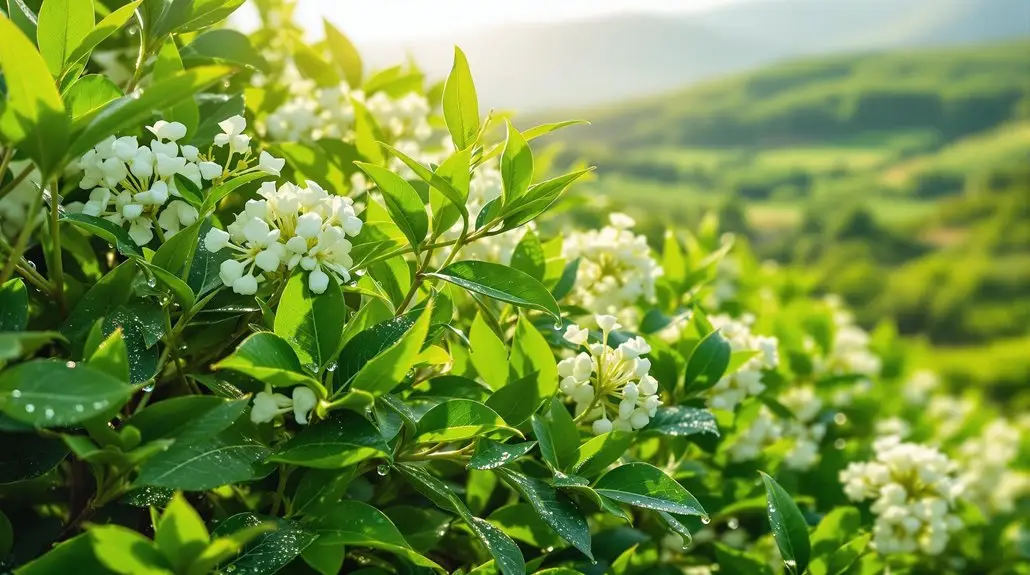
Myrtle essential oils (EOs) showcase fascinating regional variations that markedly influence their chemical composition and biological activities. If you investigate myrtle plants from different regions, you'll notice distinct differences in their EOs.
For instance, in Iran, studies reveal that 21 wild populations exhibit variations in α-pinene and 1,8-cineole levels, primarily influenced by salinity and harvesting conditions. You'll find that moderate salinity can actually boost the EO yield, making these Iranian myrtle plants unique. Essential oil yield in myrtle has been shown to vary significantly based on seasonal changes, with spring harvests often yielding the highest levels. Moreover, populations from higher altitudes tend to produce higher α-pinene and 1,8-cineole concentrations, further emphasizing the impact of environmental conditions.
When you immerse yourself in the Middle East, particularly Palestine, the EOs display even more diversity. Jericho EOs contain components like cis-4-thujanol and myrtenol, while Jenin EOs are rich in linalool and α-pinene. This variation isn't just academic; it reflects on the differing antibacterial properties of the EOs, proving that where myrtle grows matters.
In the Mediterranean, both seasonal changes and harvesting practices impact the EO composition. You'll see that berries from this region often contain geranyl acetate and methyleugenol, adding another layer of complexity.
Globally, from Greece to Tunisia, myrtle EOs maintain a core of common components but vary based on local conditions. This rich tapestry of regional differences in myrtle EOs not only highlights their diverse chemical profiles but also their potential uses in pest management, making them a fascinating subject for anyone interested in natural remedies.
Pesticide Activity Overview
In this section, you'll explore the diverse pesticide activity of myrtle, focusing on its antibacterial efficacy, insecticidal properties, and fungicidal and herbicidal effects.
You'll see how the essential oil's components work against various pests and pathogens, making it a versatile option in pest management. Additionally, the extract of myrtle has demonstrated significant antimycobacterial activity, indicating its potential to combat resistant strains of pathogens. Notably, myrtle essential oil exhibits significant insecticidal activity against various stored-product pests, enhancing its role in pest management strategies.
Understanding these activities can help you appreciate myrtle's potential in sustainable agriculture.
Antibacterial Efficacy Overview
How effective are the antibacterial properties of myrtle extracts? You'll find that these extracts exhibit remarkable antibacterial activity against several harmful bacterial strains. Research shows that essential oils from myrtle can effectively combat *Escherichia coli*, *Staphylococcus aureus*, and even methicillin-resistant *Staphylococcus aureus* (MRSA).
Additionally, methanol and ethyl acetate extracts demonstrate significant antibacterial effects with minimal inhibitory concentration (MIC) values ranging from 0.097 to 0.195 mg/mL.
- Myrtle leaf extracts not only inhibit bacterial growth but also damage bacterial cell walls.
- They effectively prevent biofilm formation, enhancing their antibacterial action.
- The diverse bioactive compounds in myrtle extracts contribute to their broad-spectrum efficacy. Moreover, studies indicate that Myrtus communis exhibits strong antibacterial activity against *Aggregatibacter actinomycetemcomitans* and *Eikenella corrodens*.
These findings suggest that myrtle extracts could be a natural alternative for treating bacterial infections. The potential applications in pharmaceuticals, especially for periodontal diseases, make them especially relevant.
As you explore the world of natural remedies, understanding the antibacterial efficacy of myrtle can help you appreciate its role in promoting health and wellness. Embracing these natural solutions may connect you to a community seeking healthier, effective alternatives.
Insecticidal Properties Highlighted
The insecticidal properties of myrtle extracts showcase impressive efficacy against a variety of pests. You'll find that the essential oil from Myrtus communis L. reveals significant LC50 values, indicating its potent action against different insect species.
Here's a quick overview of its effectiveness:
| Insect Species | LC50 (µl/l air) | Notes |
|---|---|---|
| Tetranychus urticae | 53.2 | Effective against mites |
| Trogoderma granarium (eggs) | 54.7 | Strong against stored grain |
| Aedes aegypti (larvae) | 50 ppm | 100% mortality achieved |
| Culex pipiens (adults) | 0.47 | Highly effective |
Myrtle extracts not only show high mortality rates but also reveal neurotoxic activity, activating detoxification systems in pests. The major constituents, like α-Pinene and 1,8-cineole, play a crucial role in this effectiveness, acting as fumigants and repellents. Bioassays confirm that higher concentrations result in increased mortality, emphasizing the potential of myrtle as a natural insecticide. It's fascinating how nature provides us with such potent solutions, isn't it?
Fungicidal and Herbicidal Effects
Myrtle not only excels in its insecticidal properties but also demonstrates notable fungicidal and potential herbicidal effects. The antifungal activity of Myrtus communis is significant, targeting various pathogens like Candida and Aspergillus species. For instance, the essential oil exhibits a minimal fungicidal concentration (MFC) of just 25 mg/ml against Candida albicans. This makes it a strong contender in the fight against fungal infections.
Here are some key points about Myrtus communis's effects:
- It shows antifungal activity against phytopathogenic fungi such as Rhizoctonia solani and Fusarium solani.
- Research indicates that the extracts may outperform standard antifungal drugs like clotrimazole.
- While direct studies on herbicidal effects are limited, the bioactive compounds in Myrtus communis hint at herbicidal potential. Moreover, the plant's documented antioxidant and antimicrobial effects further contribute to its appeal as a natural solution in combating plant diseases. Additionally, the high essential oil content contributes to its efficacy against various fungal pathogens.
As you explore Myrtus communis, you'll find its multifaceted applications fascinating. Whether for medicinal use or agricultural practices, this plant could be a valuable asset in combating both fungal pathogens and, potentially, unwanted weeds.
The exploration of its full capabilities is still ongoing, inviting you to join in the journey of discovery.
Antibacterial Efficacy
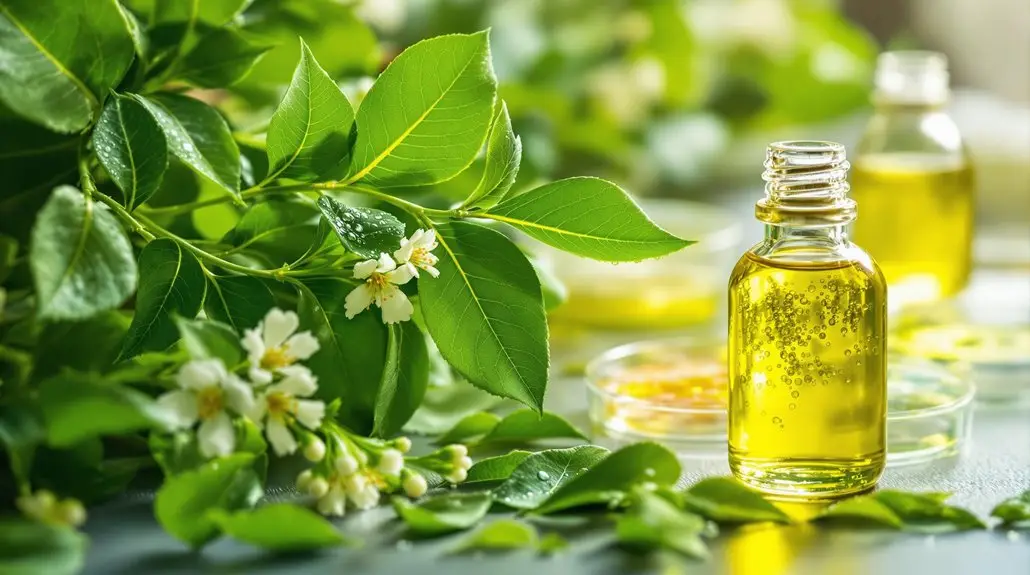
Demonstrating impressive antibacterial efficacy, extracts from Myrtus communis have shown significant activity against a range of bacterial pathogens. You'll find that both methanolic and aqueous extracts boast strong antibacterial properties, effective against both gram-positive and gram-negative bacteria.
Essential oils derived from myrtle not only inhibit bacterial growth but do so with remarkable efficiency, making them valuable allies in combatting infections.
Research indicates that myrtle extracts possess high antibacterial activity against specific strains like E. coli and S. aureus, which are notorious for causing various health issues. Using techniques like disc diffusion and broth microdilution assays, scientists have confirmed these extracts' potency, even at low concentrations, demonstrating their strong minimal inhibitory concentration (MIC) values. This means that just a little of these extracts can go a long way in fighting bacteria.
Interestingly, the antibacterial potency of myrtle extracts can vary depending on the region where they're sourced. Different compositions of these extracts lead to diverse antimicrobial activities, showcasing the adaptability and potential of Myrtus communis. Additionally, clinical strains of Aggregatibacter actinomycetemcomitans and Eikenella corrodens have been shown to be susceptible to these extracts, further supporting their therapeutic applications.
With such promising antibacterial properties, you might envision these extracts playing a role in developing new antibacterial agents for both oral and topical applications. Their natural origin makes them especially appealing for pharmaceutical use.
However, ongoing research is essential to fully reveal the therapeutic potential that Myrtus communis holds, inviting you to be part of this exciting journey into natural medicine.
Insecticidal Properties
Building on the promising antibacterial properties of Myrtus communis, its insecticidal characteristics deserve attention. This essential oil packs a powerful punch against various insects, making it a valuable asset in pest control. With major constituents like α-pinene, 1,8-cineol, limonene, and linalool, Myrtus communis exhibits remarkable insecticidal activity. In fact, studies show it's effective against pests such as mosquitoes, stored-product insects, and more.
Here are some key highlights of its insecticidal properties:
- Neurotoxic Effects: The oil impacts insects' nervous systems, as shown by its influence on acetylcholinesterase (AChE) and glutathione S-transferase (GSTs).
- Life Stage Toxicity: It's toxic at various developmental stages, from eggs to adults, ensuring thorough pest management.
- Application Methods: Fumigation stands out as a practical way to utilize this essential oil effectively.
The concentration-response relationship is clear: higher concentrations lead to increased mortality rates among targeted pests.
You'll also find that the efficacy of Myrtus communis varies depending on the species and their life stages, making it essential to tailor your approach for the best results.
Antifungal and Herbicidal Effects
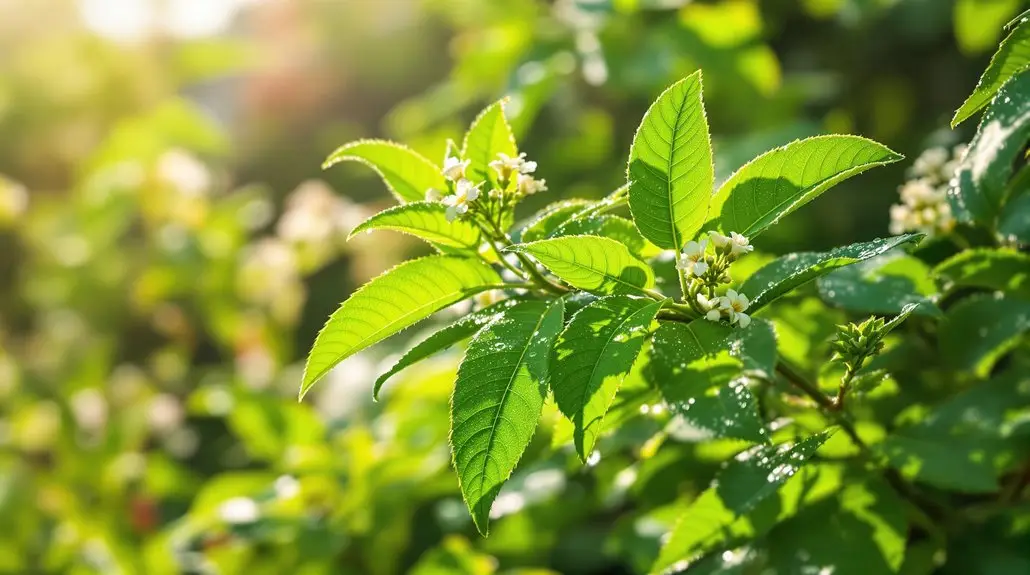
When you explore the antifungal and herbicidal effects of Myrtus communis, you'll find impressive mechanisms at play. These extracts not only suppress fungal growth but also inhibit seed germination in various plants. Understanding how these properties can be applied in agriculture opens up exciting possibilities for natural pest management. The essential oils contain high levels of oxygenated monoterpenes, which contribute significantly to their antifungal and herbicidal activities.
Fungal Inhibition Mechanisms
Myrtle's impressive antifungal properties stem from its unique chemical composition, which plays a crucial role in inhibiting fungal growth. The essential oil of *Myrtus communis* contains a variety of compounds that contribute to its antifungal efficacy, showcasing its potential as a natural remedy for fungal infections.
- Major components like α-pinene and linalool cause morphological alterations in fungal hyphae, disrupting their growth.
- The ethanolic extract effectively inhibits Candida and *Aspergillus* species, with minimum inhibitory concentration (MIC) values indicating strong activity.
- Flavonoids present in myrtle extracts enhance these antifungal effects, making it a multifaceted tool against dermatophytes.
As you explore the antifungal mechanisms of myrtle, you'll appreciate how its extracts can serve as a natural alternative to conventional antifungal treatments.
With promising results comparable to synthetic drugs like clotrimazole, myrtle offers a sense of belonging to those seeking eco-friendly solutions. Embracing myrtle not only connects you to nature but also empowers you to address fungal challenges effectively.
Seed Germination Suppression
The remarkable antifungal properties of *Myrtus communis* also hint at its potential herbicidal effects, particularly in seed germination suppression.
While there aren't direct studies showing *Myrtus communis* as a seed germination suppressor, you can draw parallels from its antifungal capabilities. Compounds in various plant extracts, including those rich in butyric acid and lactones, are known to inhibit seed germination in other species.
Just like *Ailanthus* and *Lonicera maackii*, which demonstrate specific seed suppression, *Myrtus communis* could exhibit similar qualities through its unique compounds. Additionally, certain germination inhibitors can be classified as germination retarders, which may allow for recovery under specific conditions. Furthermore, the presence of high salinity levels in soil has been shown to negatively impact seed germination, raising questions about how the extracts of *Myrtus communis* might interact with seeds.
Though salinity can impact germination negatively, with sodium chloride showing a more significant effect than sulfate, it's intriguing to ponder how the extracts of *Myrtus communis* might interact with seeds.
You might think of *Myrtus communis* as part of a broader conversation about nature's intricate balance. Its potential to inhibit seed germination reflects an essential relationship between plants, fungi, and their environment.
Embracing this knowledge can deepen your appreciation for the botanical world and its complexities.
Application in Agriculture
In recent years, the agricultural sector has increasingly turned to natural alternatives for pest and disease management, making *Myrtus communis* an appealing option.
With significant antifungal activity, this plant shows promise against harmful fungi like *Candida* and *Aspergillus*. Its essential oil contains potent compounds such as myrtenyl acetate and 1,8-cineol that contribute to its antifungal effects, making it a valuable tool in your farming toolkit.
While there's no direct evidence of its herbicidal properties, *Myrtus communis* demonstrates insecticidal activity against common pests. Its minimal residual activity guarantees protection for non-target organisms, aligning with sustainable farming practices.
Here are some key points to take into account:
- Antifungal activity is effective at low concentrations, enhancing its practicality.
- Its essential oil may act as a potential biocontrol agent in integrated pest management.
- Flavonoids within the plant further boost its antifungal capabilities.
Applications in Agriculture
Utilizing Myrtus communis essential oil in agriculture offers a promising alternative to synthetic pesticides, enhancing integrated pest management strategies. This natural oil, rich in compounds like α-Pinene and 1,8-cineole, has shown significant insecticidal and herbicidal activity against various pests and weeds. By incorporating Myrtus communis into your farming practices, you can reduce reliance on chemical pesticides while supporting a healthier ecosystem.
The essential oil's effectiveness varies based on its chemical composition, which can differ by region. For instance, oils from Turkey, Iran, and Palestine maintain high levels of oxygenated monoterpenes, essential for pest control. Here's a quick comparison of its applications:
| Application | Details |
|---|---|
| Insecticidal | Effective against stored-product pests like C. maculatus and T. confusum. |
| Herbicidal | Inhibits germination of weeds like Amaranthus retroflexus and Rumex crispus. |
| Biocontrol Agent | Minimal residual activity supports pollinator health. |
Antimicrobial Properties
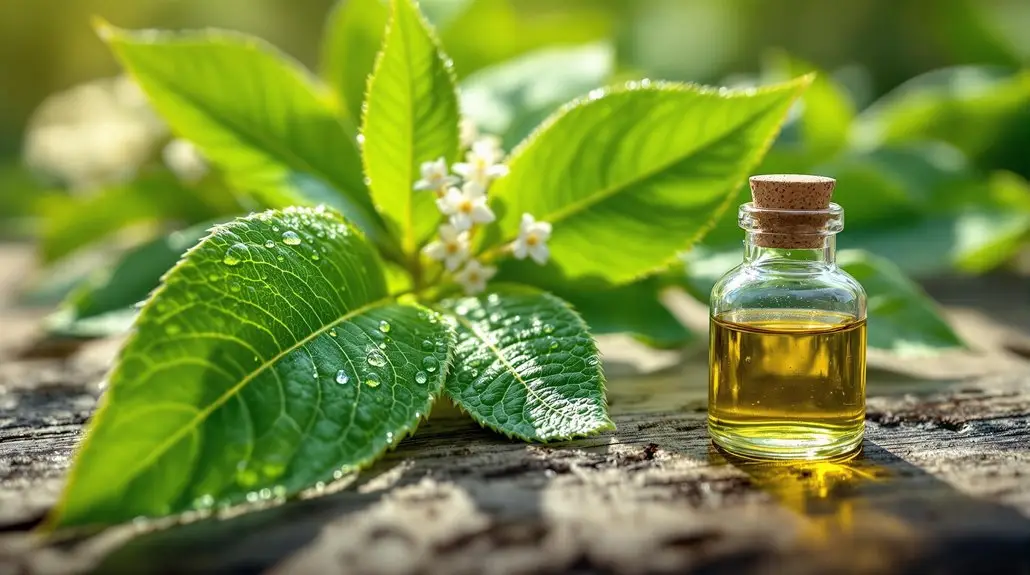
Myrtus communis L. offers remarkable antimicrobial properties that make it a valuable resource in both traditional and modern medicine. Its essential oils and extracts are packed with active compounds, like cis-4-thujanol and 1,8-cineole, which contribute to its effectiveness against a variety of pathogens.
You'll find that the essential oil is particularly potent, effectively combating bacteria such as Escherichia coli, Staphylococcus aureus, and even methicillin-resistant strains.
Here are some key points about its antimicrobial properties:
- Broad Spectrum: M. communis L. extracts and essential oils demonstrate efficacy against numerous bacterial strains, illustrating their versatility.
- Low MIC Values: The minimum inhibitory concentration (MIC) ranges from 0.049 to 0.195 mg/mL, indicating that even small quantities can inhibit bacterial growth.
- Synergistic Effects: When combined with antibiotics, these extracts can enhance antibacterial activity, providing an effective strategy against resistant strains.
Additionally, the antimicrobial effects are attributed to bioactive compounds present in the plant, reinforcing its role as a natural remedy. Notably, high-quality essential oils show higher concentrations of bioactive compounds, which further supports their effectiveness. In your pursuit of natural remedies, M. communis L. stands out as a promising option. With its demonstrated antibacterial and antifungal activities, it not only serves a medicinal purpose but also offers a sense of belonging to those who value nature's contributions to health.
Whether you're interested in its traditional uses or looking to explore modern applications, this plant connects you to a rich history of healing practices that resonate with many.
Chemical Analysis Techniques
When analyzing myrtle essential oil, you'll find several key methods that play a vital role in its characterization. From advanced techniques like gas chromatography-mass spectrometry to traditional extraction methods, each approach offers unique insights into the oil's composition. Understanding these analysis techniques will help you appreciate the complexities of myrtle's pesticidal properties. Additionally, the essential oil is known for its antibacterial and antiseptic properties, which further enhances its potential applications in pest control.
Essential Oil Characterization Methods
One effective method for characterizing vital oils is through Gas Chromatography-Mass Spectrometry (GC-MS), a powerful technique that combines the strengths of both separation and identification.
By employing a capillary column, often with a Polyethylene Glycol (PEG) stationary phase, GC-MS allows you to analyze the complex mixtures found in essential oils like myrtle. You'll appreciate how it provides detailed chemical profiles important for quality control and authentication. Quality testing is crucial to ensure oils are free from adulteration and contamination.
- It enables the detection of adulteration by comparing chemical profiles to established standards.
- You can identify specific compounds, such as monoterpenes and oxides, and determine their concentrations with precision.
- GC-MS is essential for understanding the insecticidal properties of essential oils, revealing their potential as biocontrol agents. Additionally, GC-MS provides rapid, comprehensive chemical information on samples, greatly enhancing the analysis process.
With instruments like the Pegasus BT, GC-MS employs manual injection techniques and EI-MS libraries for accurate component identification.
This method can analyze complex mixtures down to ppm levels, ensuring you get a thorough understanding of the essential oils you're working with.
Advanced Analytical Techniques
Characterizing essential oils like myrtle requires advanced analytical techniques to guarantee accuracy and reliability. You'll find that methods like liquid chromatography-tandem mass spectrometry (LC-MS/MS) are essential in detecting trace levels of compounds. These techniques boast high precision and sensitivity, making them perfect for analyzing the multiple pesticide residues that may be present in myrtle and other products. For instance, a 2D-LC-MS/MS method can analyze over 112 pesticides simultaneously, guaranteeing that you're fully aware of what's in your samples. The significant advancement in monitoring pesticide levels allows for the simultaneous detection of a wide range of pesticides.
The sensitivity and selectivity of mass spectrometry allow you to identify and quantify pesticides with remarkable accuracy. By fragmenting parent ions into daughter ions, tandem MS enhances specificity and minimizes false positives, which is crucial when analyzing complex matrices. Additionally, myrtle extracts, known for their antioxidant properties, may also interact with pesticide residues, influencing the overall safety and quality of the final product.
Plus, techniques like QuEChERS streamline extraction and cleanup, making your workflow more efficient. As you dive deeper into pesticide analysis, embracing these advanced methods will help you secure compliance with regulatory standards and maintain food integrity. Staying informed about these techniques not only enhances your analytical skills but also fosters a sense of community among those dedicated to quality and integrity in food products.
Comparison of Analysis Approaches
Comparing various chemical analysis techniques reveals distinct advantages and applications for evaluating myrtle oil composition. Each method you choose can greatly influence your understanding of its properties and potential uses.
For instance, Gas Chromatography-Mass Spectrometry (GC/MS) excels at identifying key components, such as myrtenyl acetate and α-pinene, while also revealing the essential oil's antimicrobial activity.
- Extraction Techniques: Methods like QuEChERS and ASE streamline the process of isolating pesticide residues, ensuring accuracy in environmental samples.
- Insecticidal Activity Assessment: Techniques that utilize statistical analysis, such as ANOVA, help you quantify the effectiveness of myrtle oil against pests, providing valuable insights for practical applications.
- Pesticide Residue Analysis: Advanced methods involving GC/MS can detect pesticide residues even in complex matrices like sediment samples, emphasizing the need for thorough analysis.
Frequently Asked Questions
How Is Myrtus Communis Harvested for Essential Oil Production?
To harvest Myrtus communis for essential oil, you'll typically gather young leaves and flowering twiglets between May and November.
It's best to collect them manually on the same day for freshness.
Once harvested, you load the plant material into large steel retorts for steam distillation.
This process guarantees you capture the highest quality essential oil, so teamwork and timely handling are key to achieving the best results together!
Are There Any Safety Concerns Regarding Myrtus Communis Essential Oils?
When it comes to myrtle essential oils, you'll want to tread lightly.
While these oils can be delightful in various uses, undiluted versions can be a bit too intense for your body, often causing breathing troubles and skin irritations.
If you're pregnant or have little ones around, it's wise to be extra cautious.
Always consult a trusted practitioner to guarantee you're enjoying the benefits securely and responsibly, keeping everyone protected and happy.
What Methods Are Used to Apply Myrtus Communis as a Pesticide?
When applying Myrtus communis as a pesticide, you can use methods like fumigation, where essential oils are dispersed at varying concentrations.
You might also prepare extracts by macerating the leaves in methanol, then testing these in petri dishes with insects. Monitoring mortality rates at different time intervals helps you assess effectiveness.
Combining extracts with other substances can enhance results, making it an exciting area to explore for pest management strategies.
Can Myrtus Communis Essential Oils Affect Non-Target Organisms?
Yes, Myrtus communis essential oils can affect non-target organisms, but the impact tends to be lower compared to synthetic pesticides.
Their volatile nature and minimal residual activity reduce environmental risks, making them more compatible with integrated pest management.
While they may have beneficial antioxidant and hepatoprotective effects, caution is key.
You should always consider concentration and exposure time to minimize unintended consequences for beneficial insects and other non-target organisms.
How Can I Incorporate Myrtus Communis Into My Pest Management Plan?
Like a secret weapon in your gardening arsenal, incorporating Myrtus communis into your pest management plan can be a game-changer.
Start by creating a spray formulation from its essential oil, targeting pests in your stored products or garden. Rotate it with synthetic pesticides to manage resistance, and always monitor its effects.
Remember to follow label directions to guarantee security for both your plants and beneficial insects. You'll find a balance that nurtures your environment beautifully.
Conclusion
In exploring the pesticidal potential of myrtle, you've uncovered a treasure trove of benefits. With its potent essential oils, you've seen how they combat bacteria, thwart fungi, and even silence stubborn weeds. You've witnessed the regional variations that add to its charm, and you've discovered the versatile applications in agriculture. Myrtle stands as nature's shield, offering a fragrant yet fierce defense against pests, proving that beauty and utility can flourish side by side in the garden.
Now, it's time to harness the power of myrtle for your own gardening needs! Embrace the natural solution to pest control with NaturePest Holistic Pest Control. Our products utilize the incredible properties of myrtle to keep your garden thriving and pest-free. Join the movement towards a more sustainable approach to pest management—visit us today and discover how you can integrate myrtle into your gardening practices!

